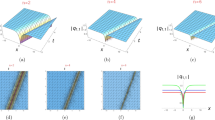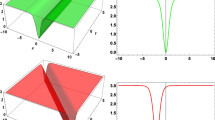Abstract
We consider two dimensional nonstationary scattering of plane waves by a NN-wedge. We prove the existence and uniqueness of a solution to the corresponding mixed problem and we give an explicit formula for the solution. Also the Limiting Amplitude Principle is proved and a rate of convergence to the limiting amplitude is obtained.






Similar content being viewed by others
References
Babich, V.M., Lyalinov, M.A., Grikurov, V.E.: Diffraction Theory: The Sommerfeld-Malyuzhinets Technique. Alpha Science International (2007)
Bernard, J.M.L.: Diffraction by a metallic wedge covered by a dielectric material. Wave Motion 9, 543–561 (1987)
Bernard, J.M.L.: On the time domain scattering by a passive classical frequency dependent wedge-shaped region in a lossy dispersive medium. Ann. Telecommun. 49(11–12), 673–683 (1994)
Bernard, J.M.L., Pelosi, G., Manara, G., Freni, A.: Time domain scattering by an impedance wedge for skew incidence. In: Proceedings Conference ICEAA, pp. 11–14 (1991)
Bernard, J.M.L.: Progresses on the diffraction by a wedge: transient solution for line source illumination, single face contribution to scattered field, and new consequence of reciprocity on the spectral function. Rev. Tech. Thomson 25(4), 1209–1220 (1993)
Borovikov, V.A., Kinber, V.Y.: Geometrical Theory of Diffraction. The Institution of Electrical Engineers, London (1994)
Bouche, D., Molinet, F., Mittra, R.: Asymptotic Methods in Electromagnetics. Springer, Berlin (1995)
Castro, L.P., Kapanadze, D.: Exterior wedge diffraction problems with Dirichlet, Neumann and impedance boundary conditions. Acta Appl. Math. 110(1), 289–311 (2010)
Castro, L.P., Kapanadze, D.: Wave diffraction by a 270 degrees wedge sector with Dirichlet, Neumann and impedance boundary conditions. Proc. A. Razmadze Math. Inst. 01(155), 96–99 (2011)
Choque, A., Karlovich, Y., Merzon, A., Zhevandrov, P.: On the convergence of the amplitude of the diffracted nonstationary wave in scattering by wedges. Russ. J. Math. Phys. 19(3), 373–384 (2012)
Clemmow, P.C.: The Plane Wave Spectrum Representation of Electromagnetic Fields. Pergamon, Oxford (1966)
Duduchava, R., Tsaava, M.: Mixed boundary value problems for the Helmholtz equation in arbitrary 2D-sectors. Georgian Math. J. 20(3), 439–467 (2013)
Felsen, L.B.: Diffraction of the pulsed field from an arbitrarily oriented electric or magnetic dipole by a perfectly conducting wedge. SIAM J. Appl. Math. 26(2), 306–312 (1974)
Hewett, D.P., Ockendon, J.R., Allwright, D.J.: Switching on a two-dimensional time-harmonic scalar wave in the presence of a diffracting edge. Wave Motion 48(3), 197–213 (2011)
Keller, J., Blank, A.: Diffraction and reflection of pulses by wedges and corners. Commun. Pure Appl. Math. 4(1), 75–95 (1951)
Komech, A.I., Mauser, N.J., Merzon, A.E.: On Sommerfeld representation and uniqueness in scattering by wedges. Math. Methods Appl. Sci. 28, 147–183 (2005)
Komech, A.I., Merzon, A.E.: Limiting amplitude principle in the scattering by wedges. Math. Methods Appl. Sci. 29, 1147–1185 (2006)
Komech, A.I., Merzon, A.E., De la Paz Mendez, J.E.: On justifcation of Sobolev’s formula for diffraction by wedge. http://arxiv.org/submit/0988200
Komech, A., Merzon, A., Zhevandrov, P.: A method of complex characteristics for elliptic problems in angles and its applications. Transl. Am. Math. Soc. 206(2), 125–159 (2002)
Komech, A.I., Merzon, A.E.: Relation between Cauchy data for the scattering by a wedge. Russ. J. Math. Phys. 14(3), 279–303 (2007)
Komech, A.I.: Linear partial differential equations with constant coefficients. In: Egorov Yu, E., Komech, A.I., Shubin, M.A. (eds.) Elements of the Modern Theory of Partial Differential Equations, pp. 127–260. Springer, Berlin (1999)
Malyuzhinets, G.D.: Excitation, reflection and emission of the surface waves on a wedge with given impedances of the sides. Dokl. Akad. Nauk SSSR 121(3), 436–439 (1958)
Malyuzhinets, G.D.: Inversion formula for the Sommerfeld integral. Sov. Phys. Dokl. 3, 52–56 (1958)
Meister, E., Penzel, F., Speck, F.O., Teixeira, F.S.: Some interior and exterior boundary-value problems for the Helmholtz equations in a quadrant. Proc. R. Soc. Edinb. A 123(2), 275–294 (1993)
Meister, E., Speck, F.O., Teixeira, F.S.: Wiener-Hopf-Hankel operators for some wedge diffraction problems with mixed boundary conditions. J. Integral Equ. Appl. 4(2), 229–255 (1992)
Merzon, A., De la Paz Mendez, J.E.: DN-Scattering of a plane wave by wedges. Math. Methods Appl. Sci. 34(15), 1843–1872 (2011). http://onlinelibrary.wiley.com/doi/10.1002/mma.1484/abstract
Merzon, A.E., Speck, F.O., Villalba, T.J.: On the weak solution of the Neumann problem for the 2D Helmholtz equation in a convex cone and H s regularity. Math. Methods Appl. Sci. 34(1), 24–43 (2011)
Oberhettinger, F.: Diffraction of waves by a wedge. Commun. Pure Appl. Math. 7(3), 551–563 (1954)
Oberhettinger, F.: On the diffraction and reflection of waves and pulses by wedges and corners. J. Res. Natl. Inst. Stan. 61(2) (1958)
Petrashen, C.I., Nikolaev, V.G., Kouzov, D.P.: On the series method in the theory of diffraction waves by polygonal regions. Nauch. Zap. LGU 246(5), 5–70 (1958) (in Russian)
Rottbrand, K.: Exact solution for time-dependent diffraction of plane waves by semi-infinite soft/hard wedges and half-planes. Preprint, 1984, Technical University Darmstadt (1998)
Rudin, W.: Real and Complex Analysis. McGraw-Hill, New York (1987)
Sobolev, S.L.: Theory of Diffraction of Plane Waves. Proc. of Seis. Inst., vol. 41. Russian Academy of Science, Leningrad (1934)
Sobolev, S.L.: General theory of diffraction of waves on Riemann surfaces. Tr. Fiz.-Mat. Inst. Steklova 9, 39–105 (1935) (Russian) (English translation: Sobolev S.L.: General theory of diffraction of waves on Riemann surfaces, in: Selected Works of S.L. Sobolev, I, Springer, New York, pp. 201–262 (2006))
Sobolev, S.L.: On the problem of diffraction of plane waves. In: Frank, F., Mises, R. (eds.) Differential and Integral Equations of Mathematical Physics, pp. 605–616. ONTI, Leningrad (1937). (in Russian)
Sommerfeld, A.: Mathematische Theorie der Diffraction. Math. Ann. 47, 317–341 (1896)
Merzon, A.E., Zhevandrov, P.N.: On the Neumann problem for the Helmholtz equation in a plane angle. Math. Methods Appl. Sci. 23(16), 1401–1446 (2000)
Acknowledgements
The work is supported by Promep (México) via “Proyecto de redes”, and CONACyT (México). Also authors express the profound gratitude to professors A. Komech, P. Zhevandrov and L. Castro for fruitful discussions and to the doctor E. Tsvid for the help in preparation for the manuscript preparation.
Author information
Authors and Affiliations
Corresponding author
Appendices
Appendix 1
Lemma 11.1
The function H N (β), defined by (11), has the following properties
-
(i)
H N (−β+iπ)=−H N (β), for any \(\beta\in \mathbb{C}\).
-
(ii)
H N (β+2iΦ)=H N (β), for any \(\beta\in \mathbb{C}\).
Proof
It follows directly from (11). □
Lemma 11.2
The function \(\widehat{u}_{s}\) given in (20) satisfies “stationary” NN-problem (19).
Proof
It is easy to check that \(f_{1}(\rho,\theta,\omega) := - \widehat{g}(\omega) e^{i\rho\omega\cos(\theta-\alpha)}\) satisfies system (19). Therefore by (20), to prove (19) for \(\widehat{u}_{s}\) it suffices to prove that
satisfies for any ρ>0
The Helmholtz equation in (92) follows by differentiation of the integral (91) after the change of variable β↦β′−iθ, since (Δ+ω 2)e −ρωsinh(β−iθ)=0. Moreover, the integral in (91) converges absolutely after the differentiation for any \(\omega\in\mathbb{C}^{+}\) by (21), the condition \(\omega\in\mathbb{C}^{+}\) and (11).
Let us prove that f 2 satisfies the second equality of (92). Since \(\frac{\partial}{\partial y_{2} } |_{\theta=2\pi}=\frac{1}{\rho }\cdot\frac{\partial}{\partial\theta} |_{\theta=2\pi}\) it suffices to prove that
Since \(\frac{\partial}{\partial\theta} = i\, \frac{\mathrm{d}}{\mathrm {d}\beta}\) and the integral \(\int_{\mathcal{C}} e^{-\rho\omega\sinh\beta}\frac {\partial}{\partial\theta} H_{N}(\beta+i\theta) \,\mathrm{d} \beta \) converges uniformly with respect to θ (by (21), \(\omega \in\mathbb{C}^{+}\) and (11)) to prove (93) it suffices to prove that
The function \(e^{-\rho\omega\sinh\beta}\frac{\mathrm{d} }{\mathrm{d}\beta} H_{N}(\beta+2i\pi)\) is invariant with respect to \(\mathcal{S}(\beta)=-\beta-3i\pi\), for any \(\beta\in\mathcal {C}\). It follows from Lemma 11.1, i) and the fact that \(\frac{\mathrm{d} }{\mathrm{d}\beta}\, H_{N}(\beta+2i\pi)\) is invariant with respect to \(\mathcal{S}(\beta)\) for any \(\beta\in\mathcal{C}\). Hence (94) holds by the symmetry of \(\mathcal{C}\) given in (21) with respect to \(-i\frac{3\pi}{2}\), see Fig. 4.
Let us prove that f 2 satisfies the third equality of (92). Since (91), \(\frac{\partial}{\partial\mathbf{n}_{2} } |_{\theta=\phi} = -\frac{1}{\rho}\cdot\frac{\partial}{\partial \theta} |_{\theta=\phi}\), \(\frac{\partial}{\partial\theta} = i\, \frac{\mathrm{d}}{\mathrm {d}\beta}\), and the fact that the integral \(\int_{\mathcal{C}} e^{-\rho\omega\sinh\beta}\frac {\partial}{\partial\theta} H_{N}(\beta+i\theta) \,\mathrm{d} \beta \) converges uniformly with respect to θ (by (21), \(\omega \in\mathbb{C}^{+}\) and (11)), it suffices to prove that \(\int_{\mathcal{C}} e^{-\rho\omega\sinh\beta} \frac {\mathrm{d}\ }{\mathrm{d}\beta} H_{N}(\beta+i\phi) \,\mathrm{d} \beta= 0\). Integrating by parts and using that for any \(\beta\in\mathcal{C}\), H N (β+iϕ) is a bounded function and e −ρωsinhβ⟶0 when \(\vert\operatorname{Re} \beta\vert \rightarrow+\infty\) we obtain \(\int_{\mathcal{C}} e^{-\rho\omega\sinh\beta} \frac {\mathrm{d}}{\mathrm{d}\beta} H_{N}(\beta+i\phi) \,\mathrm{d} \beta = \rho\omega\int_{\mathcal{C}} e^{-\rho\omega\sinh\beta} \cosh \beta\, H_{N}(\beta+i\phi)\, \mathrm{d}\beta\). The last integral is equal to 0, because of the invariance of the integrand with respect to −β−3iπ, for any \(\beta\in \mathcal{C}\) and by the symmetry of \(\mathcal{C}\) with respect to \(-i\frac{3\pi}{2}\). □
Appendix 2
Proof of Lemma 4.3
(i) The analytic continuation of \(\widehat{g}(\omega_{1})\) to \(\mathbb{C}^{+}\) and (37) follow from the Paley-Wiener type theorem for convex cones ([21, Theorem I.5.2]) since suppf⊂[0,∞) by (2). The estimate (38) follows from (2) since \(\omega_{0}\in \mathbb{R}\).
(ii) \(f'\in C_{0}^{\infty}(\mathbb{R})\) since supp(f′) is a compact set by (2) and \(f\in C^{\infty}(\mathbb{R})\). Hence existence of the analytic continuation of \(\widehat{g}_{1}(\omega_{1})\) to \(\mathbb{C}\) and (40) follow from the Classic Paley-Wiener Theorem [32]. It is easy to check that \(\widehat{g}_{1}(\omega)=(\omega-\omega _{0})\widehat{g}(\omega)\), for any \(\omega\in\mathbb{C}^{+}\) by (34), (35) and the Analytic Continuation Principle. This implies the first identity in (41). Hence, the second identity in (41) follows from (37) and (40). The statement (42) follows from the first identity in (41) and (39). □
Appendix 3
Definition 13.1
For a function h(s), we denote the jump of h(s), at a point \(s=s^{*}\in\mathbb{R}\) as \(\mathfrak{J}(h,s^{*}) := \lim_{\varepsilon\rightarrow0+} h(s^{*} + i \varepsilon) - \lim_{\varepsilon\rightarrow0+} h(s^{*} - i \varepsilon)\), if the limits exist.
Lemma 13.2
Let \(f\in\mathrm{C}_{0}(\mathbb{R})\) and for |ε|≤1 let \(F(\varepsilon) := \frac{1}{2i\pi}\int_{-\infty }^{\infty} f(s) \coth(qs+i\varepsilon)\,\mathrm{d}s\). Then there exist the limits lim ε→0+ F(ε), lim ε→0− F(ε) and \(\mathfrak{J}(F,0) = -\frac{1}{q}\ f(0)\).
Proof
It follows by the Sokhotsky-Plemelj theorem. □
Lemma 13.3
Let u r , u d be the functions given by (17) and (10), respectively. Then
Proof
We consider the case θ=θ 1. The case θ=θ 2 is analyzed similarly.
First we find \(\mathfrak{J} (\frac{\partial ^{(k)}u_{r}}{\partial\theta^{k}}, \theta_{1} )\). From (17) it follows that
Using polar coordinates y=(ρcosθ,ρsinθ) in u r,1 and making the change of variable β=−i(θ−θ 1) we obtain \(u_{r,1}(\rho,\theta_{1},t) = e^{-i\omega_{0}(t-\rho\cos(\theta-\theta_{1}))} f(t-\rho\cos (\theta-\theta_{1})) = A(\beta,\rho,t)\), where
Then \(\frac{\partial^{(k)} }{\partial\theta^{k}} u_{r,1}(\rho,\theta,t) = (-i)^{k} \frac{\partial^{(k)} }{\partial\beta^{k}} A(\beta,\rho ,t)\), \(k\in\mathbb{N}_{0}\). Hence by (96) we obtain
Now we find \(\mathfrak{J} (\frac{\partial^{(k)} u_{d}}{\partial\theta^{k}} ,\theta_{1} )\). From (18) and (11) it follows that Z N (ρ,θ,t)=coth[q(β+iθ−iθ 1)]+coth[q(β+iθ−iθ 2)]−coth[q(β+iθ−2iπ−iα)]−coth[q(β+iθ−iα)]. Since function coth[q(β+iθ−iθ 1)] is discontinuous in θ=θ 1, then Z N (ρ,θ,t) is also discontinuous in θ=θ 1. Hence from (51) we have that
where \(u_{1}(\rho,\theta,t) = -\frac{q}{2i\pi} \int_{-\infty}^{+\infty} A(\beta ,\rho,t) \coth[ q(\beta+ i\theta- i\theta_{1} ) ] \,\mathrm{d}\beta\) and A(β,ρ) is given by (97). Using \(\frac{\partial }{\partial\theta} \coth[ q(\beta+ i\theta- i\theta_{1} ) ] = i\frac{\partial }{\partial\beta} \coth[ q(\beta+ i\theta- i\theta_{1} ) ]\), integrating by parts k times (for k=0 we do not integrate \(\frac {\partial^{(k)} u_{1}}{\partial\theta^{k}}\)), and using that by (2) the integration is realized on a compact interval, we obtain \(\frac{\partial^{(k)} }{\partial\theta^{k}} u_{1}(\rho,\theta,t) = (-1)^{k-1}\frac{i^{k} q}{2i\pi} \int_{-\infty }^{+\infty} \frac{\partial^{(k)} }{\partial\beta^{k}} A(\beta,\rho,t) \cdot \coth[ q(\beta+ i\theta- i\theta_{1}) ] \,\mathrm{d}\beta\). Applying Lemma 13.2 with \(f(\beta)=(-1)^{k-1} i^{k} q \frac {\partial^{(k)} }{\partial\beta^{k}} A(\beta,\rho,t)\) we obtain
Therefore (95) follows from (99), (100) and (98). □
Appendix 4
Lemma 14.1
The function \([\frac{t}{t+\sqrt{t^{2} - \rho^{2}}} ]^{m}\) admits the following asymptotic behavior
Rights and permissions
About this article
Cite this article
Navarrete, A.E., Merzon, A. An Explicit Formula for the Nonstationary Diffracted Wave Scattered on a NN-Wedge. Acta Appl Math 136, 119–145 (2015). https://doi.org/10.1007/s10440-014-9943-7
Received:
Accepted:
Published:
Issue Date:
DOI: https://doi.org/10.1007/s10440-014-9943-7




